overheating DODGE CHARGER SRT 2018 Owners Manual
[x] Cancel search | Manufacturer: DODGE, Model Year: 2018, Model line: CHARGER SRT, Model: DODGE CHARGER SRT 2018Pages: 490, PDF Size: 5.08 MB
Page 80 of 490

NOTE:
•It is not necessary to move the temperature settings for
cold or hot vehicles. The system automatically adjusts
the temperature, mode, and blower speed to provide
comfort as quickly as possible.
• The temperature can be displayed in U.S. or Metric units
by selecting the US/Metric customer-programmable fea-
ture. Refer to the “Uconnect Settings” in “Multimedia”
for further information.
To provide you with maximum comfort in the Automatic
mode during cold start-ups, the blower fan will remain on
low until the engine warms up. The blower will increase in
speed and transition into Auto mode.
Manual Operation Override
This system offers a full complement of manual override
features. The AUTO symbol in the front ATC display will
be turned off when the system is being used in the manual
mode.
Operating Tips
NOTE: Refer to the chart at the end of this section for
suggested control settings for various weather conditions.
Summer Operation
The engine cooling system must be protected with a
high-quality antifreeze coolant to provide proper corrosion
protection and to protect against engine overheating. OAT
coolant (conforming to MS.90032) is recommended.
Winter Operation
To ensure the best possible heater and defroster perfor-
mance, make sure the engine cooling system is functioning
properly and the proper amount, type, and concentration
of coolant is used. Use of the Air Recirculation mode
during Winter months is not recommended, because it may
cause window fogging.
Vacation/Storage
Before you store your vehicle, or keep it out of service (i.e.,
vacation) for two weeks or more, run the air conditioning
system at idle for about five minutes, in fresh air with the
blower setting on high. This will ensure adequate system
lubrication to minimize the possibility of compressor dam-
age when the system is started again.
78 GETTING TO KNOW YOUR VEHICLE
Page 96 of 490
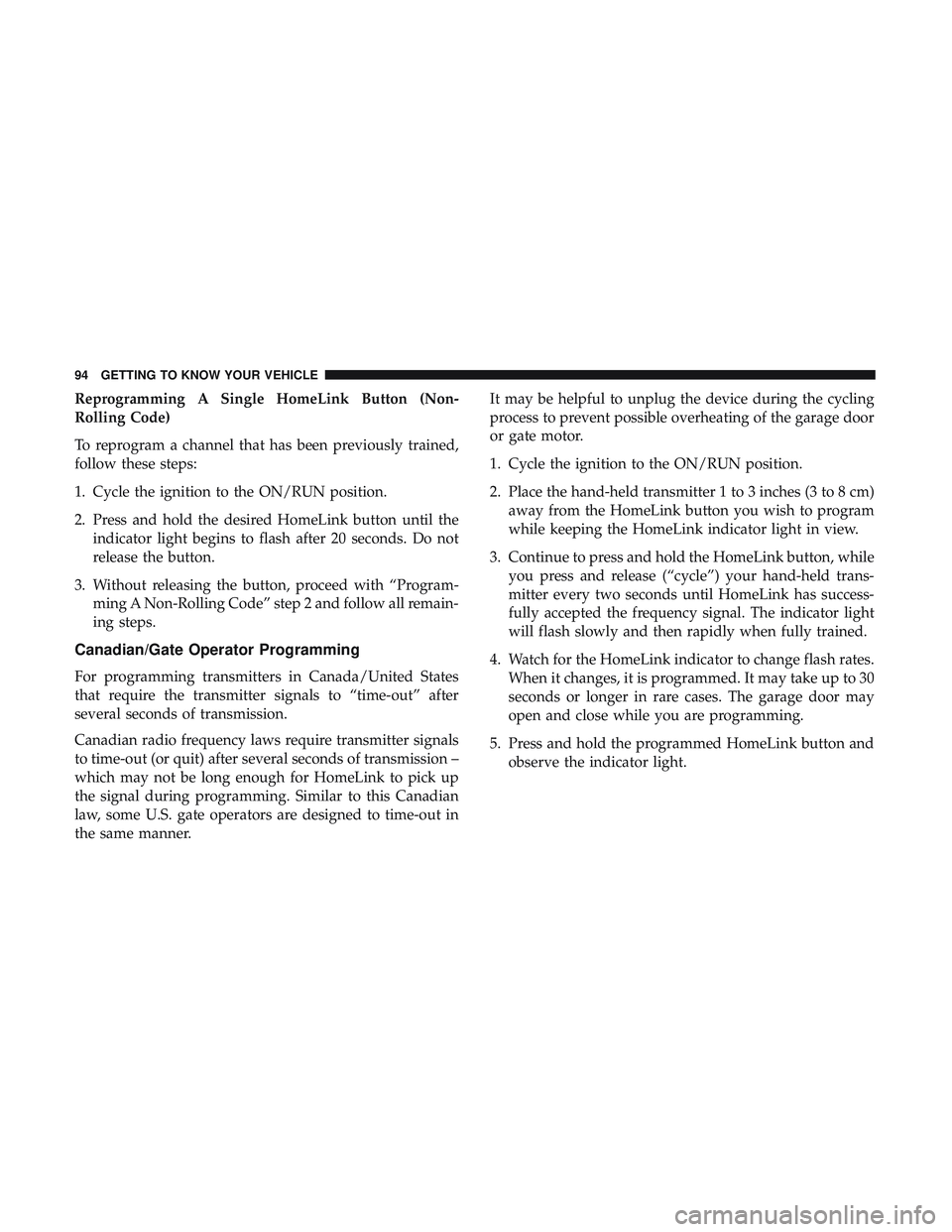
Reprogramming A Single HomeLink Button (Non-
Rolling Code)
To reprogram a channel that has been previously trained,
follow these steps:
1. Cycle the ignition to the ON/RUN position.
2. Press and hold the desired HomeLink button until theindicator light begins to flash after 20 seconds. Do not
release the button.
3. Without releasing the button, proceed with “Program- ming A Non-Rolling Code” step 2 and follow all remain-
ing steps.
Canadian/Gate Operator Programming
For programming transmitters in Canada/United States
that require the transmitter signals to “time-out” after
several seconds of transmission.
Canadian radio frequency laws require transmitter signals
to time-out (or quit) after several seconds of transmission –
which may not be long enough for HomeLink to pick up
the signal during programming. Similar to this Canadian
law, some U.S. gate operators are designed to time-out in
the same manner. It may be helpful to unplug the device during the cycling
process to prevent possible overheating of the garage door
or gate motor.
1. Cycle the ignition to the ON/RUN position.
2. Place the hand-held transmitter 1 to 3 inches (3 to 8 cm)
away from the HomeLink button you wish to program
while keeping the HomeLink indicator light in view.
3. Continue to press and hold the HomeLink button, while you press and release (“cycle”) your hand-held trans-
mitter every two seconds until HomeLink has success-
fully accepted the frequency signal. The indicator light
will flash slowly and then rapidly when fully trained.
4. Watch for the HomeLink indicator to change flash rates. When it changes, it is programmed. It may take up to 30
seconds or longer in rare cases. The garage door may
open and close while you are programming.
5. Press and hold the programmed HomeLink button and observe the indicator light.
94 GETTING TO KNOW YOUR VEHICLE
Page 314 of 490
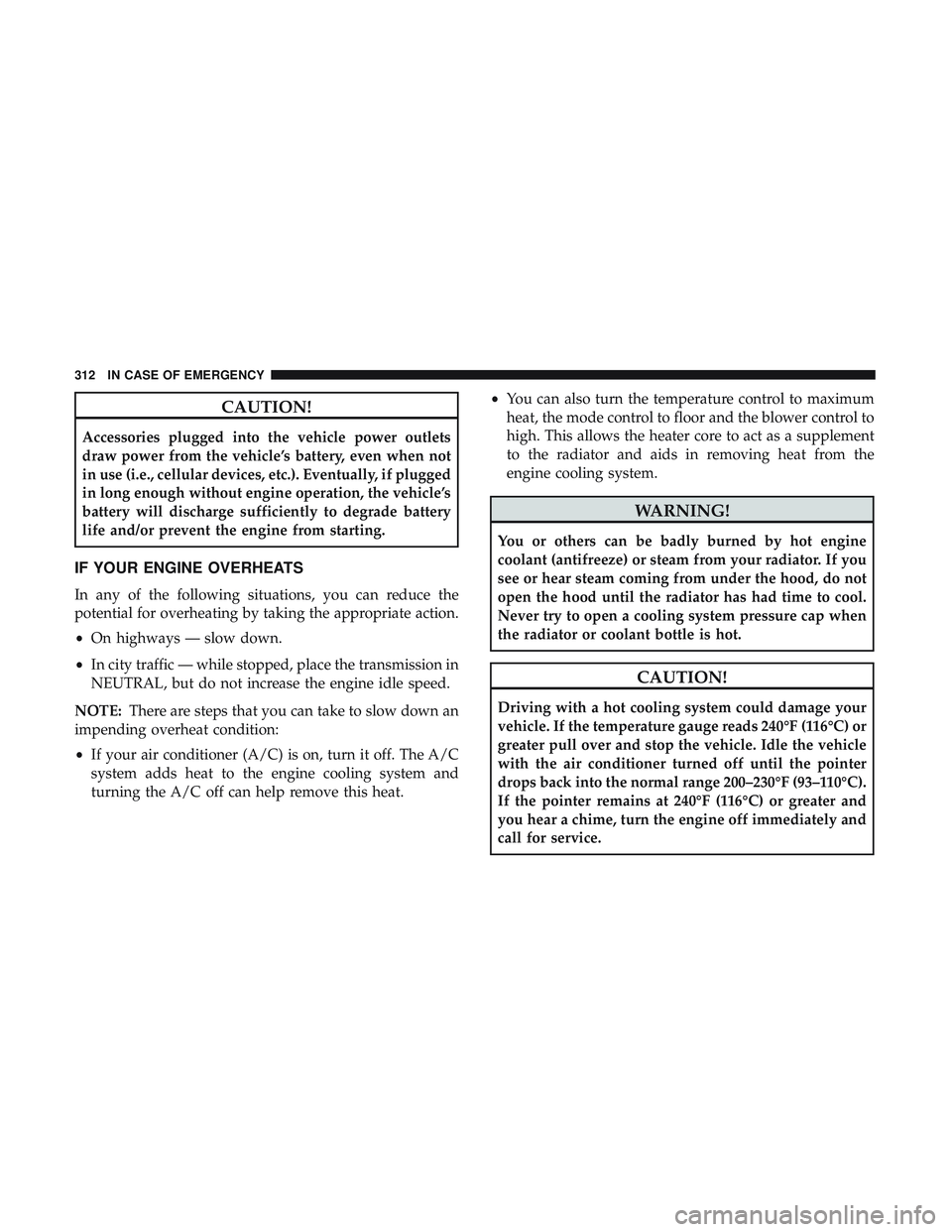
CAUTION!
Accessories plugged into the vehicle power outlets
draw power from the vehicle’s battery, even when not
in use (i.e., cellular devices, etc.). Eventually, if plugged
in long enough without engine operation, the vehicle’s
battery will discharge sufficiently to degrade battery
life and/or prevent the engine from starting.
IF YOUR ENGINE OVERHEATS
In any of the following situations, you can reduce the
potential for overheating by taking the appropriate action.
•On highways — slow down.
• In city traffic — while stopped, place the transmission in
NEUTRAL, but do not increase the engine idle speed.
NOTE: There are steps that you can take to slow down an
impending overheat condition:
• If your air conditioner (A/C) is on, turn it off. The A/C
system adds heat to the engine cooling system and
turning the A/C off can help remove this heat. •
You can also turn the temperature control to maximum
heat, the mode control to floor and the blower control to
high. This allows the heater core to act as a supplement
to the radiator and aids in removing heat from the
engine cooling system.
WARNING!
You or others can be badly burned by hot engine
coolant (antifreeze) or steam from your radiator. If you
see or hear steam coming from under the hood, do not
open the hood until the radiator has had time to cool.
Never try to open a cooling system pressure cap when
the radiator or coolant bottle is hot.
CAUTION!
Driving with a hot cooling system could damage your
vehicle. If the temperature gauge reads 240°F (116°C) or
greater pull over and stop the vehicle. Idle the vehicle
with the air conditioner turned off until the pointer
drops back into the normal range 200–230°F (93–110°C).
If the pointer remains at 240°F (116°C) or greater and
you hear a chime, turn the engine off immediately and
call for service.
312 IN CASE OF EMERGENCY
Page 318 of 490
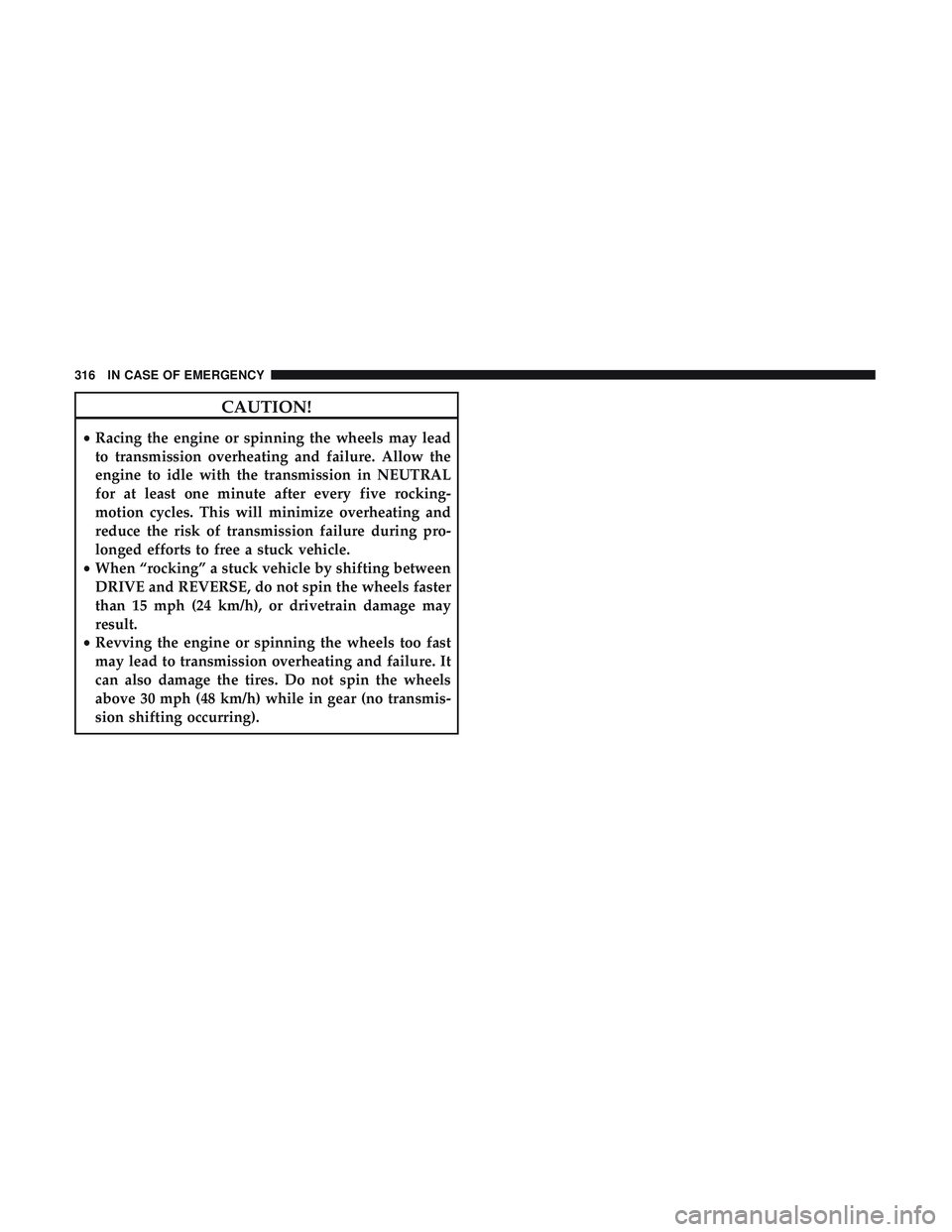
CAUTION!
•Racing the engine or spinning the wheels may lead
to transmission overheating and failure. Allow the
engine to idle with the transmission in NEUTRAL
for at least one minute after every five rocking-
motion cycles. This will minimize overheating and
reduce the risk of transmission failure during pro-
longed efforts to free a stuck vehicle.
• When “rocking” a stuck vehicle by shifting between
DRIVE and REVERSE, do not spin the wheels faster
than 15 mph (24 km/h), or drivetrain damage may
result.
• Revving the engine or spinning the wheels too fast
may lead to transmission overheating and failure. It
can also damage the tires. Do not spin the wheels
above 30 mph (48 km/h) while in gear (no transmis-
sion shifting occurring).
316 IN CASE OF EMERGENCY
Page 340 of 490
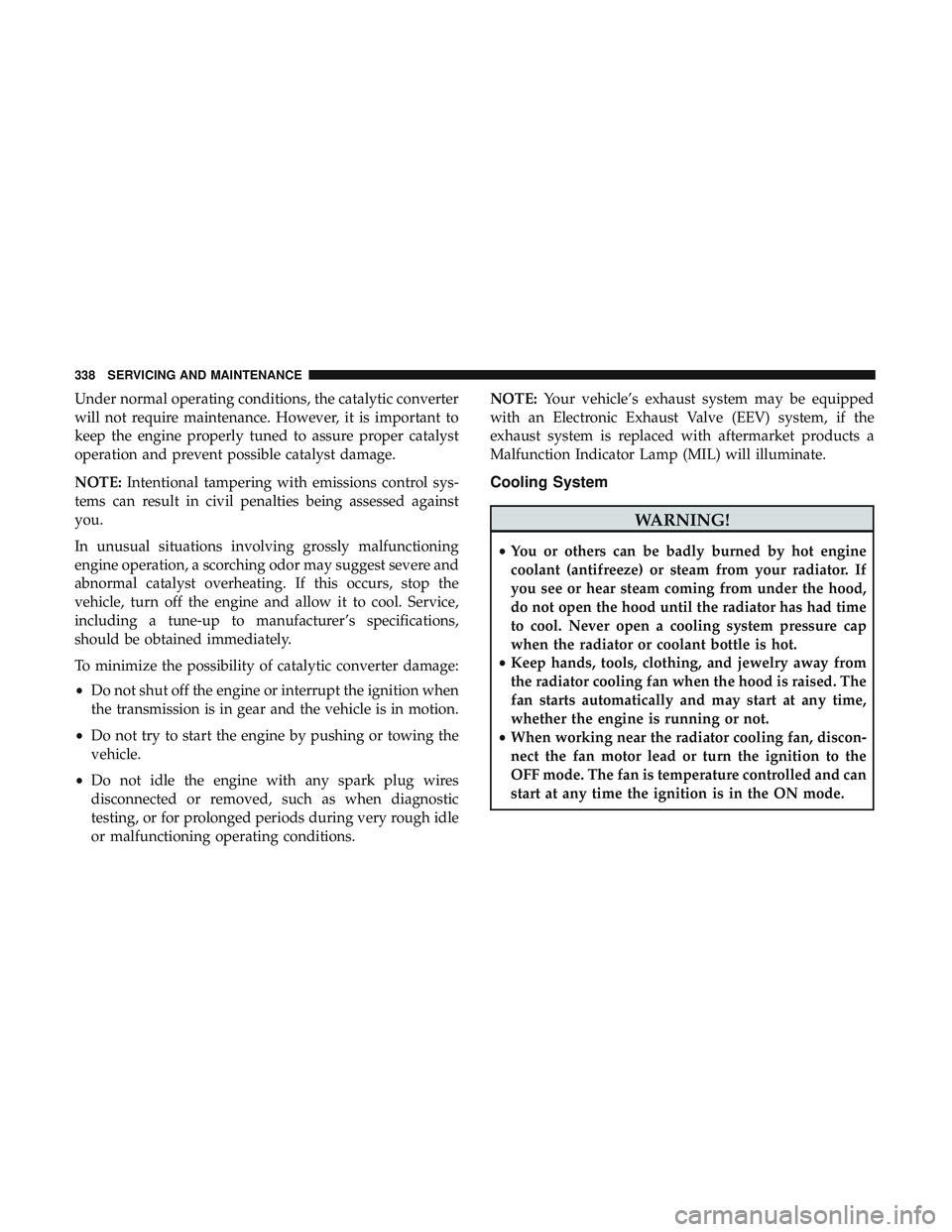
Under normal operating conditions, the catalytic converter
will not require maintenance. However, it is important to
keep the engine properly tuned to assure proper catalyst
operation and prevent possible catalyst damage.
NOTE:Intentional tampering with emissions control sys-
tems can result in civil penalties being assessed against
you.
In unusual situations involving grossly malfunctioning
engine operation, a scorching odor may suggest severe and
abnormal catalyst overheating. If this occurs, stop the
vehicle, turn off the engine and allow it to cool. Service,
including a tune-up to manufacturer’s specifications,
should be obtained immediately.
To minimize the possibility of catalytic converter damage:
• Do not shut off the engine or interrupt the ignition when
the transmission is in gear and the vehicle is in motion.
• Do not try to start the engine by pushing or towing the
vehicle.
• Do not idle the engine with any spark plug wires
disconnected or removed, such as when diagnostic
testing, or for prolonged periods during very rough idle
or malfunctioning operating conditions. NOTE:
Your vehicle’s exhaust system may be equipped
with an Electronic Exhaust Valve (EEV) system, if the
exhaust system is replaced with aftermarket products a
Malfunction Indicator Lamp (MIL) will illuminate.
Cooling System
WARNING!
• You or others can be badly burned by hot engine
coolant (antifreeze) or steam from your radiator. If
you see or hear steam coming from under the hood,
do not open the hood until the radiator has had time
to cool. Never open a cooling system pressure cap
when the radiator or coolant bottle is hot.
• Keep hands, tools, clothing, and jewelry away from
the radiator cooling fan when the hood is raised. The
fan starts automatically and may start at any time,
whether the engine is running or not.
• When working near the radiator cooling fan, discon-
nect the fan motor lead or turn the ignition to the
OFF mode. The fan is temperature controlled and can
start at any time the ignition is in the ON mode.
338 SERVICING AND MAINTENANCE
Page 358 of 490
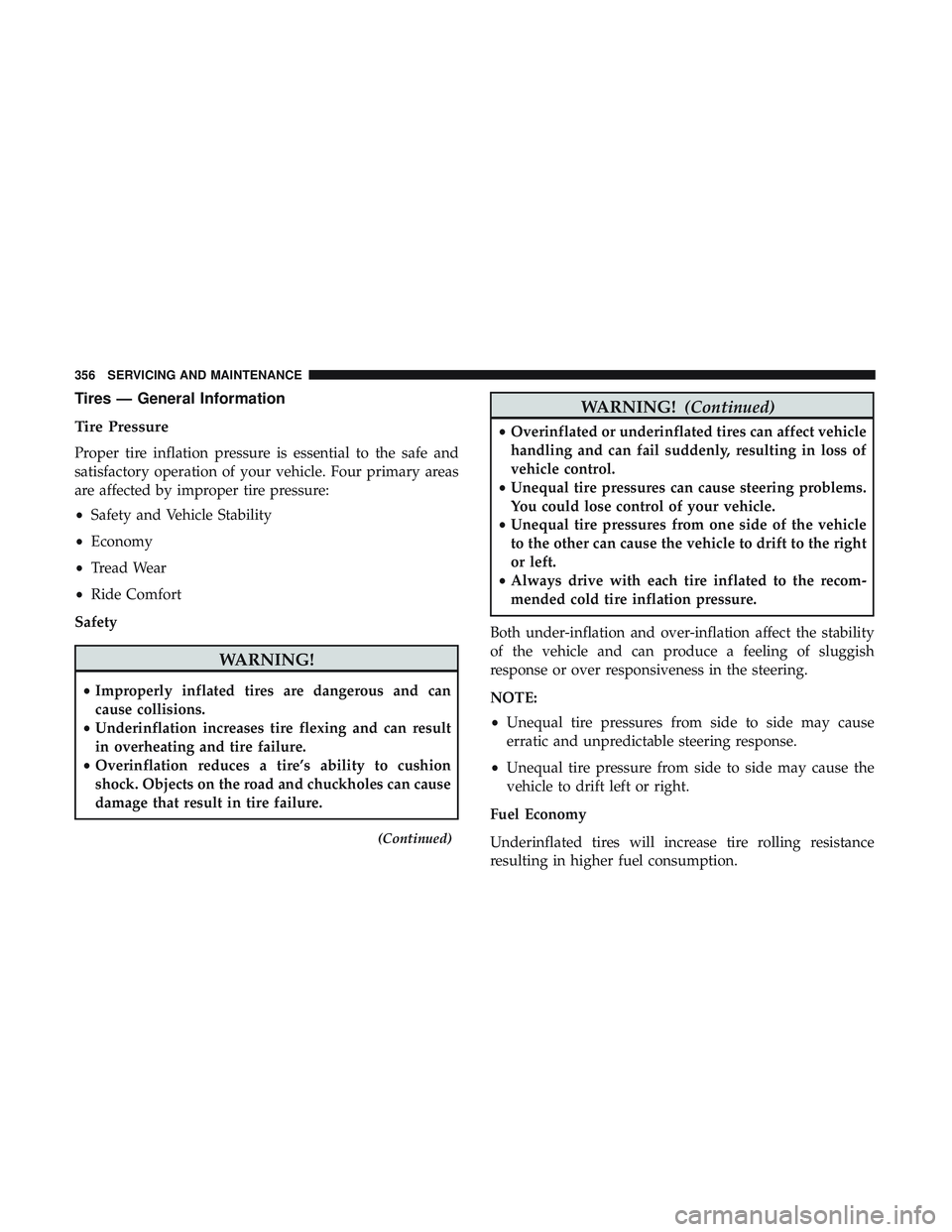
Tires — General Information
Tire Pressure
Proper tire inflation pressure is essential to the safe and
satisfactory operation of your vehicle. Four primary areas
are affected by improper tire pressure:
•Safety and Vehicle Stability
• Economy
• Tread Wear
• Ride Comfort
Safety
WARNING!
• Improperly inflated tires are dangerous and can
cause collisions.
• Underinflation increases tire flexing and can result
in overheating and tire failure.
• Overinflation reduces a tire’s ability to cushion
shock. Objects on the road and chuckholes can cause
damage that result in tire failure.
(Continued)
WARNING! (Continued)
•Overinflated or underinflated tires can affect vehicle
handling and can fail suddenly, resulting in loss of
vehicle control.
• Unequal tire pressures can cause steering problems.
You could lose control of your vehicle.
• Unequal tire pressures from one side of the vehicle
to the other can cause the vehicle to drift to the right
or left.
• Always drive with each tire inflated to the recom-
mended cold tire inflation pressure.
Both under-inflation and over-inflation affect the stability
of the vehicle and can produce a feeling of sluggish
response or over responsiveness in the steering.
NOTE:
• Unequal tire pressures from side to side may cause
erratic and unpredictable steering response.
• Unequal tire pressure from side to side may cause the
vehicle to drift left or right.
Fuel Economy
Underinflated tires will increase tire rolling resistance
resulting in higher fuel consumption.
356 SERVICING AND MAINTENANCE
Page 477 of 490
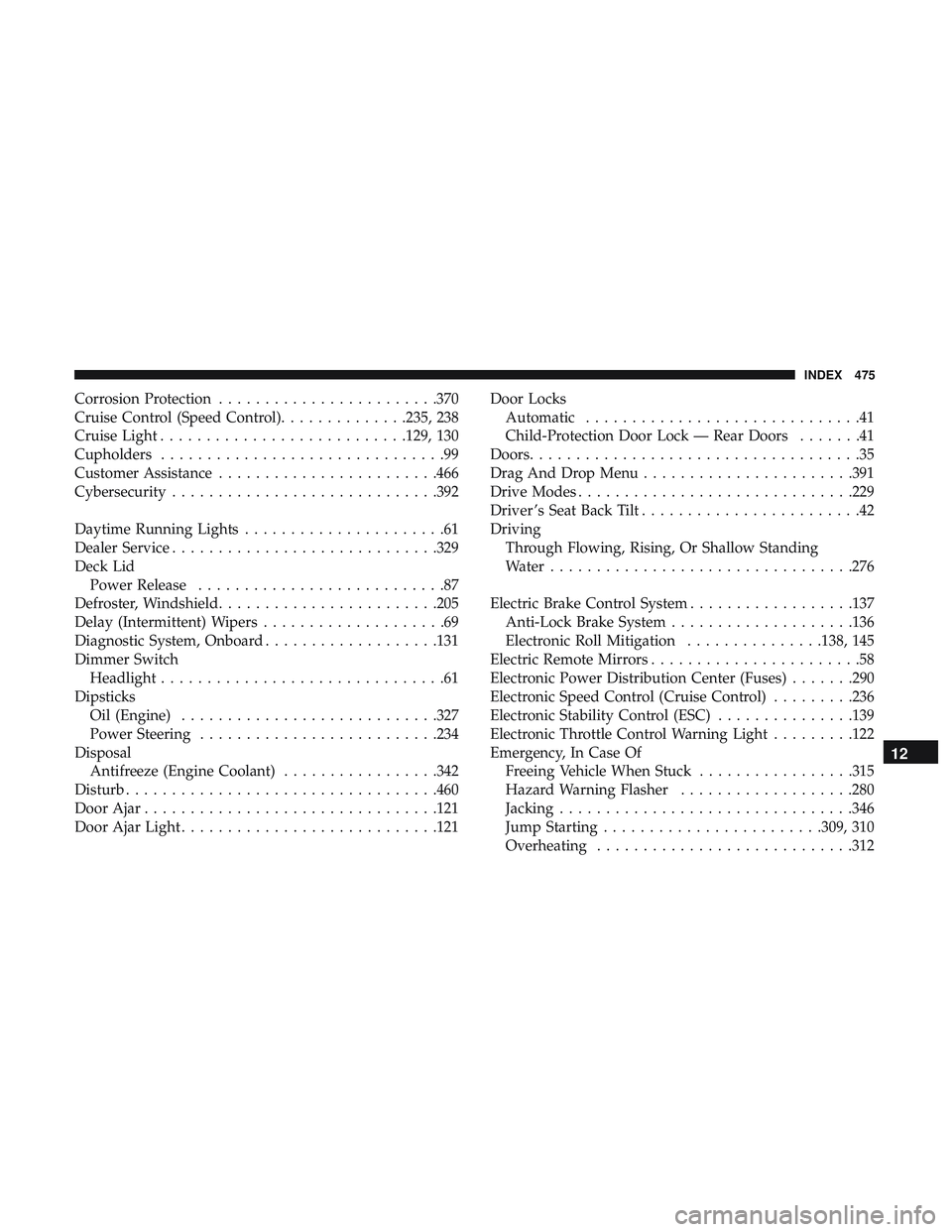
Corrosion Protection........................370
Cruise Control (Speed Control) ..............235, 238
Cruise Light .......................... .129, 130
Cupholders ...............................99
Customer Assistance ........................466
Cybersecurity ............................ .392
Daytime Running Lights ......................61
Dealer Service ............................ .329
Deck Lid Power Release ...........................87
Defroster, Windshield ........................205
Delay (Intermittent) Wipers ....................69
Diagnostic System, Onboard ...................131
Dimmer Switch Headlight ...............................61
Dipsticks Oil (Engine) ............................327
Power Steering ..........................234
Disposal Antifreeze (Engine Coolant) .................342
Disturb ................................. .460
Door Ajar ............................... .121
Door Ajar Light ............................121 Door Locks
Automatic ..............................41
Child-Protection Door Lock — Rear Doors .......41
Doors ....................................35
Drag And Drop Menu .......................391
Drive Modes ............................. .229
Driver ’s Seat Back Tilt ........................42
Driving Through Flowing, Rising, Or Shallow Standing
Water .................................276
Electric Brake Control System ..................137
Anti-Lock Brake System ....................136
Electronic Roll Mitigation ...............138, 145
Electric Remote Mirrors .......................58
Electronic Power Distribution Center (Fuses) .......290
Electronic Speed Control (Cruise Control) .........236
Electronic Stability Control (ESC) ...............139
Electronic Throttle Control Warning Light .........122
Emergency, In Case Of Freeing Vehicle When Stuck .................315
Hazar d
Warning Flasher ...................280
Jacking ............................... .346
Jump Starting ........................309, 310
Overheating ............................312
12
INDEX 475
Page 478 of 490
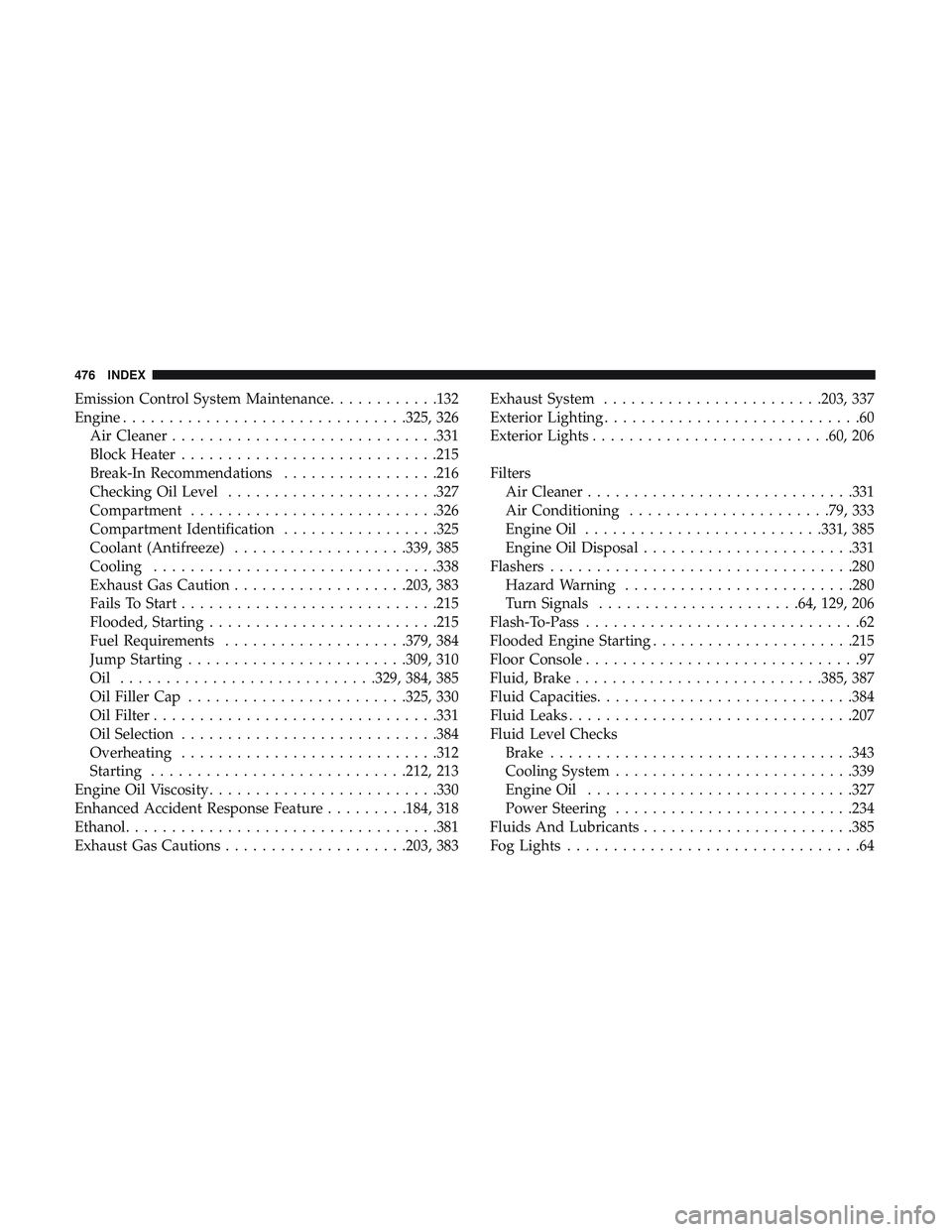
Emission Control System Maintenance............132
Engine ...............................325, 326
Air Cleaner ............................ .331
Block Heater ............................215
Break-In Recommendations .................216
Checking Oil Level .......................327
Compartment .......................... .326
Compartment Identification .................325
Coolant (Antifreeze) ...................339, 385
Cooling ...............................338
Exhaust Gas Caution ...................203, 383
Fails To Start ............................215
Flooded, Starting ........................ .215
Fuel Requirements ....................379, 384
Jump Starting ........................309, 310
Oil ............................329, 384, 385
Oil Filler Cap ........................325, 330
Oil Filter ...............................331
Oil Selection ............................384
Overheating ............................312
Starting ............................212, 213
Engine Oil Viscosity ........................ .330
Enhanced Accident Response Feature .........184, 318
Ethanol ................................. .381
Exhaust Gas Cautions ....................203, 383 Exhaust System
........................203, 337
Exterior Lighting ............................60
Exterior Lights ..........................60, 206
Filters Air Cleaner ............................ .331
Air Conditioning ..................... .79, 333
Engine Oil ..........................331, 385
Engine Oil Disposal .......................331
Flashers .................................280
Hazard Warning ........................ .280
Turn Signals ..................... .64,129,
206
Flash-To-Pass ..............................62
Flooded Engine Starting ..................... .215
Floor Console ..............................97
Fluid, Brake .......................... .385, 387
Fluid Capacities ............................384
Fluid Leaks ...............................207
Fluid Level Checks Brake .................................343
Cooling System ..........................339
Engine Oil ............................ .327
Power Steering ..........................234
Fluids And Lubricants .......................385
Fog Lights ................................64
476 INDEX
Page 482 of 490
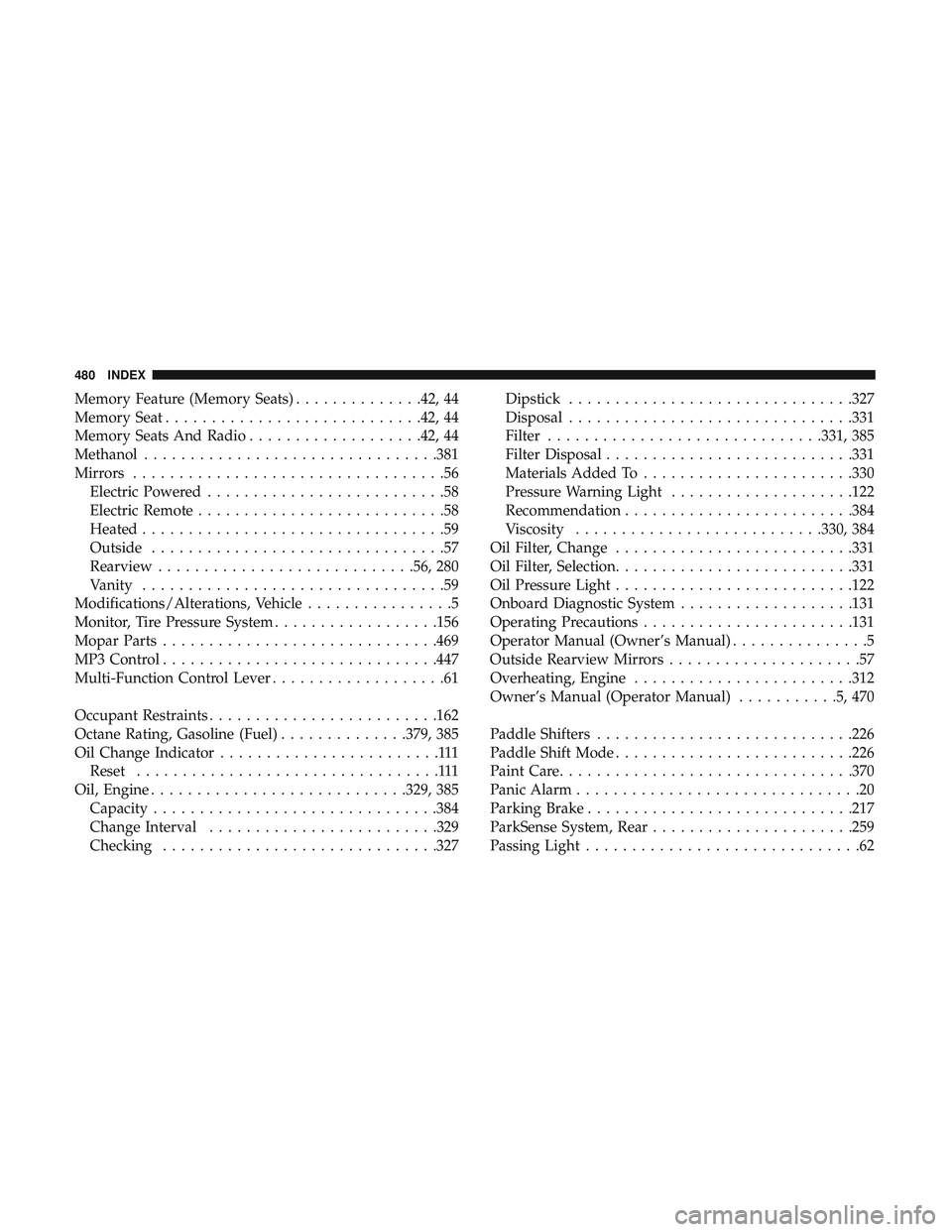
Memory Feature (Memory Seats)..............42, 44
Memory Seat ............................42, 44
Memory Seats And Radio ...................42, 44
Methanol ............................... .381
Mirrors ..................................56
Electric Powered ..........................58
Electric Remote ...........................58
Heated .................................59
Outside ................................57
Rearview ............................56, 280
Vanity .................................59
Modifications/Alterations, Vehicle ................5
Monitor, Tire Pressure System ..................156
Mopar Parts ............................. .469
MP3 Control ............................. .447
Multi-Function Control Lever ...................61
Occupant Restraints ........................ .162
Octane Rating, Gasoline (Fuel) ..............379, 385
Oil Change Indicator ........................111
Reset .................................111
Oil, Engine ............................329, 385
Capacity ...............................384
Change Interval ........................ .329
Checking ............................. .327Dipstick
...............................327
Disposal ...............................331
Filter ............................. .331, 385
Filter Disposal .......................... .331
Materials Added To .......................330
Pressure Warning Light ....................122
Recommendation ........................ .384
Viscosity .......................... .330, 384
Oil Filter, Change ..........................331
Oil Filter, Selection ..........................331
Oil Pressure Light ..........................122
Onboard Diagnostic System ...................131
Operating Precautions .......................131
Operator Manual (Owner’s Manual) ...............5
Outside
Rearview Mirrors .....................57
Overheating, Engine ........................312
Owner’s Manual (Operator Manual) ...........5,470
Paddle Shifters ............................226
Paddle Shift Mode ..........................226
Paint Care ............................... .370
Panic Alarm ...............................20
Parking Brake ............................ .217
ParkSense System, Rear ..................... .259
Passing Light ..............................62
480 INDEX